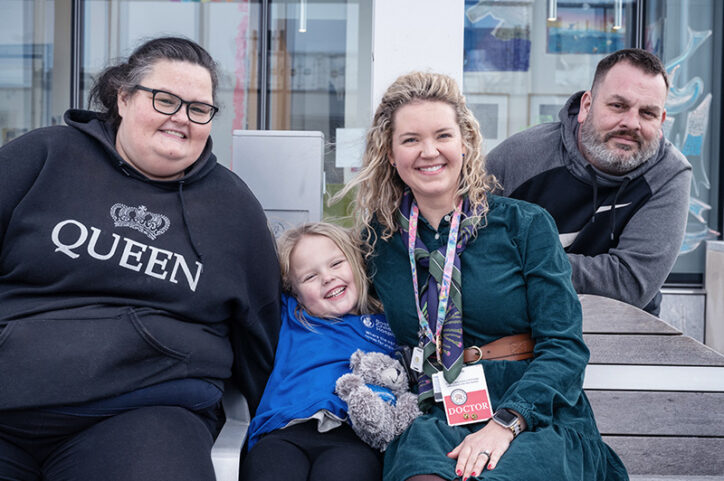‘They never stopped trying to figure out what was happening’: RyennAnne’s encephalitis journey

When 5-year-old RyennAnne Hurst developed a bad sore throat last summer, her doctor thought she might have strep and prescribed her antibiotics. But two weeks later, she wasn’t feeling any better. In fact, she was lethargic and her head hurt.
“She told us it felt like something was smashing into the right side of her head,” remembers her mom, Courtney.
She and RyennAnne’s father, Keith, rushed RyennAnne to their local emergency room in New Hampshire.
“We were not going to leave until we had an answer for her,” says Keith.
There, further testing, including a CT scan, revealed that the cause of RyennAnne’s symptoms was far more troubling than strep throat: She was experiencing bleeding and swelling in her brain. The team in New Hampshire recommended that she be med-flighted to Boston Children’s Hospital.

In the midst of a ‘nightmare,’ gratitude
Once in Boston, RyennAnne was admitted to the hospital and underwent more tests. With three other children at home and a lot of uncertainty, Keith admits that the next five days in the ICU were “a nightmare.” At the same time, the Hursts say they were grateful to be in a place where they felt everyone was trying to find answers for RyennAnne.
“From day one, we felt welcomed with open arms by everyone,” says Courtney. That included Dr. Molly Wilson-Murphy from Boston Children’s Neuroimmunology Center. “She and her team are amazing,” Keith adds. “They talked with us like adults, didn’t use complicated medical terms, and never stopped trying to figure out what was happening with RyennAnne.”

At last, a diagnosis
Soon, there was a surprising answer: RyennAnne had herpes simplex encephalitis. This type of brain inflammation occurs in response to an infection by the herpes simplex virus (HSV) — typically HSV-1, a common virus that also causes cold sores. Most people never develop severe problems from HSV-1; in fact, the virus can remain dormant in the body for years without causing symptoms. However, it can sometimes trigger potentially life-threatening encephalitis.
With a diagnosis in hand, RyennAnne’s care team quickly developed a treatment plan, which included a course of intravenous anti-viral medications and anti-seizure drugs. Her parents credit the many nurses who cared for her during her 17-day stay with helping her feel comfortable, adjust to taking yucky-tasting medications and vitamins, and — when she was on the mend — keeping her entertained.
“They were super nice and played Barbies with me,” says RyennAnne.

Moving ahead after encephalitis
Now, more than six months later, RyennAnne is back home and returning to the business of being a kid — running around, watching “Monsters, Inc.,” and of course playing with Barbie dolls. When she experienced anxiety after going back to school, she leaned on a special friend for support: her teddy bear, Safety, who was a gift from her friends on her med flight to Boston Children’s.
And although she still gets tired easily as her body recovers, her parents are grateful for the care she’s received.
“If we didn’t have Dr. Wilson-Murphy, we’d never have this diagnosis,” says Keith.
Learn more about the Neuroimmunology Center.
Related Posts :
-

After a severe case of myelitis, ‘rockstar’ Maxwell is on the move
When Maxwell Lazarz’s mother, Jennifer, tells him he’s a rockstar, he just laughs and asks her what that ...
-

‘A lot better now’: Andrew’s recovery from Rocky Mountain spotted fever and a stroke
When Andrew was bitten by a tick in 2021, he and his parents could hardly have imagined that just a month ...
-

Acute flaccid myelitis (AFM): What parents need to know
If you’re a parent, chances are you’ve heard the recent news reports about acute flaccid myelitis, or AFM. ...
-

The mystery of Jane’s left shoulder: Acute flaccid myelitis
When 5-year-old Jane Morehead tumbled off her bike in May 2017, it didn’t seem like a big deal. Jane’s ...





